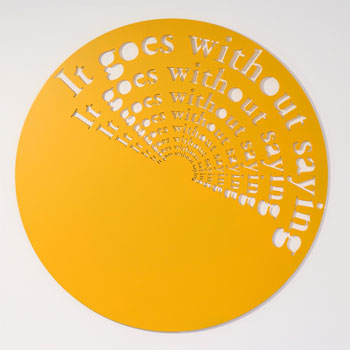
Continuing through December 17, 2011
In this show of new work, which runs the gamut from video, sculpture, metal wall pieces, silkscreens, a photo, a book, and custom curtains — there are a dozen pieces in all — New York–based conceptual artist, curator, and editor Matt Keegan expands on the readymade. Whereas readymades as we often think of them, a la Duchamp, are literally already-created objects, Keegan co-opts “readymade” words, letters, and images: well-used phrases and words (taken from his mother’s ESL vocabulary flash cards), the alphabet, and stock images, which allows for a great deal of artistic license, especially where text is concerned: he must choose/create font, material, color, size, and so on. And he uses this freedom to great effect.
Several of the phrase-based works are of steel, the words laser-cut and repeated again and again. The repetition serves to visually reinforce the process of language learning and, for the non-learner/English only speaker, implores us to reconsider patterns of speech that are taken for granted and thereby lose any real impact — clichés are almost a non-language by virtue of their banality. One of these steel works that nicely utilizes materials to turn a too-oft-used-so-now-insincere break-up phrase on its head is “It’s Not You It’s Me.” The self-reflecting phrase is cut out of a shiny, mirror-like piece of silver steel (repeatedly) thereby reflecting the viewer in the work. The work becomes accusatory, as though it is asking “what does saying this say about you?”
“No, No, No,” into which the title word has been cut numerous times into a hexagon-shaped piece of steel, the visual effect of the rhythmically repetitive cutouts lends the work an almost three-dimensional or opt art feel. The rows of ‘O’s quickly vibrate in your field of vision — neutralizing or eschewing the meaning of the word in exchange for focusing on formal elements of pattern and design.
Pointing most obviously to Keegan’s use of flash cards is the looped video, “‘N’ is for Nancy,” which features a split screen. On one side is a woman from the shoulders up, stating words or phrases in English, with the Spanish translation at the bottom of the screen; the other side features a stock image of what the woman is describing. This highlights an implicit side-effect of language teaching: it imparts a particular way of life, a particular socioeconomic status, a hierarchy of what is important or relevant to know — that is, it says a lot about the culture associated with that language.
Perhaps the most poignant work is the 26 steel letters, blocky and roughly six inches high each, that comprise “How is an Alphabet a Mother?” It is certainly not a stretch to believe that Keegan’s point here is to stimulate reflection on the power that these letters possess to give birth to an entire language, which itself has such a tremendous impact on personal identity, culture, worldview, and social interaction.
It is in his well-edited, pared-down simplicity that Keegan shines; his ability to take an idea, a phrase, a word, an image and tease out something greater. By keeping it simple, he invites us to consider his choices and how they resonate with us.
